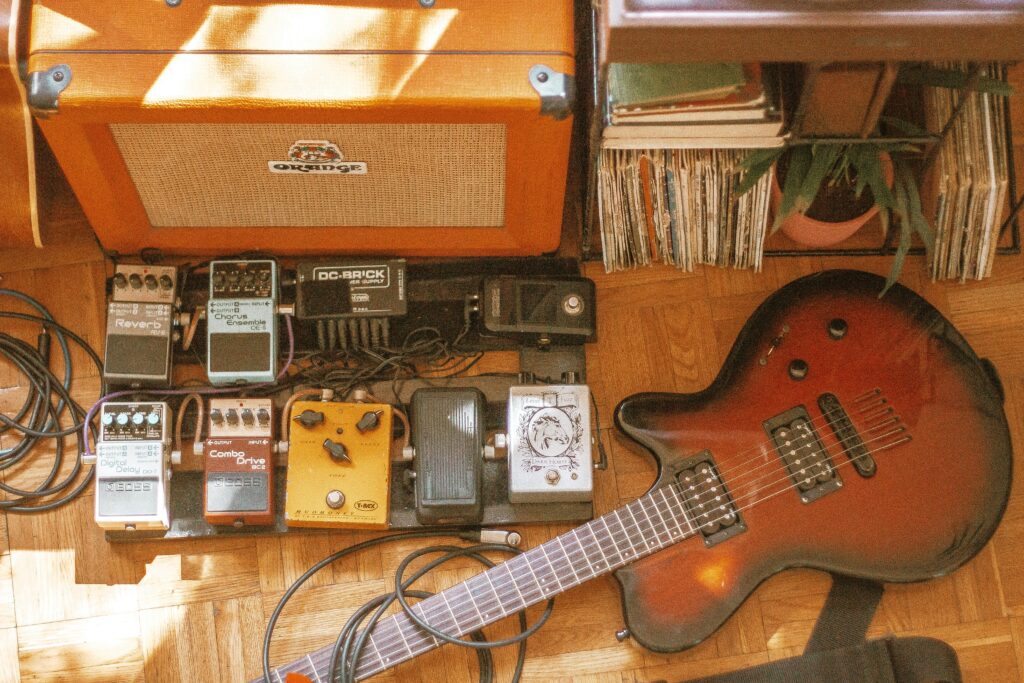
Diving into the world of guitar pedalboards for the first time can be a daunting task. With so many types of pedals to experiment with, countless pieces of new equipment to try, and plenty of confusing new terminology to learn, it’s no wonder that so many new guitar players simply don’t know where to start. But, there’s no need to worry because Pedal Pad’s pedalboard terminology guide is here to clear up all the confusion.
Whether you’re a newbie looking for a solid beginner’s pedalboard setup or a seasoned veteran who wants to unlock brand new sonic possibilities, there’s always room to learn something new and review the fundamentals. So, here is everything you need to know about pedalboard terminology, along with some general tips to help you build a better, more optimized board.
Before you can move on to the more complicated terms and equipment, let’s start with the very basics. While many people use the word “pedalboard” to describe their entire effects rig, at its core, a pedalboard is simply a platform you can put guitar effects pedals on.
Connecting all of your effects pedals together and to their power sources loose on the floor would be incredibly messy. Still, a pedalboard keeps everything connected in one set position, making setup and transportation of your rig much easier and more manageable.
Beyond the pedalboard itself, the fundamental terms to understand are the pedal and the signal chain. The signal chain is the sequence formed by connecting all your effects pedals.
Understanding the various pedal types is crucial when constructing your signal chain. While there’s no single “correct” order, each pedal influences the others, so this knowledge will help you build an effective setup from the start.
For example, if you’re new to pedalboards, here is a good guitar effects pedal signal chain order explained.
Next, let’s talk about the power supply. Each effects pedal on your board requires electricity to operate. There are various power options available, and selecting the appropriate one is crucial for meeting your pedals’ requirements and preserving your desired tone.
There are essentially two different types of power supplies. The first one, called a daisy chain, has become an increasingly essential piece of guitar gear for beginners everywhere. This affordable and convenient option allows you to power multiple pedals with one outlet by connecting multiple daisy chain adapters. This is by far the easiest power supply option, but there are limitations on what types of pedals you can use with it. Daisy chains also tend to introduce unwanted hum and other background noises that can muddy up your tone.
If you want to do the right thing from the start, you should opt for an isolated power supply. These types of power supplies prevent any unwanted interference by providing power to each pedal separately. Many isolated power supplies also allow you to power pedals with different voltage needs, allowing you to mix and match the pedals on your board as you please.

Patch cables are essential for connecting pedals in a signal chain, ensuring the input signal flows seamlessly from one pedal to the next and holds the entire chain together. While signal chains have been discussed, the method of connecting each pedal within that chain relies on these small but crucial cables.
Other than that, all you need to know is that patch cables typically come with one of two different types of connectors.
At the end of the day, patch cables are what hold your whole signal chain together, so make sure that you always have high-quality, reliable cables that won’t degrade your tone.
One of the more complicated terms that you’ll need to familiarize yourself with is true bypass vs buffered switching, which just refers to how an effects pedal manages the signal when it’s not on.
The important thing to remember is that both types of pedals complement each other and can make up for each other’s drawbacks in a way, so it’s best to have a board with an even mix of both types.
Understanding fundamental pedalboard terminology is crucial for constructing your initial setup. To further assist you, we’ve also included essential tips for organizing your pedalboard. Here is some additional guidance for your pedalboard journey.

Want to apply all the knowledge you learned from this pedalboard terminology guide to make your dream pedalboard? Give us a call, or contact us on our website, pedalpad.com. At Pedal Pad, we specialize in handcrafting one-of-a-kind custom pedalboards that allow guitar players complete freedom to build the perfect board for them. Combining high-quality materials, a durable and convenient hardcase design, and countless unique optional features like built-in power switches, audio jacks, and more, the possibilities are truly endless. So, don’t settle for some boring mass-produced pedalboard when you don’t have to. Contact Pedal Pad and start building your dream board today!